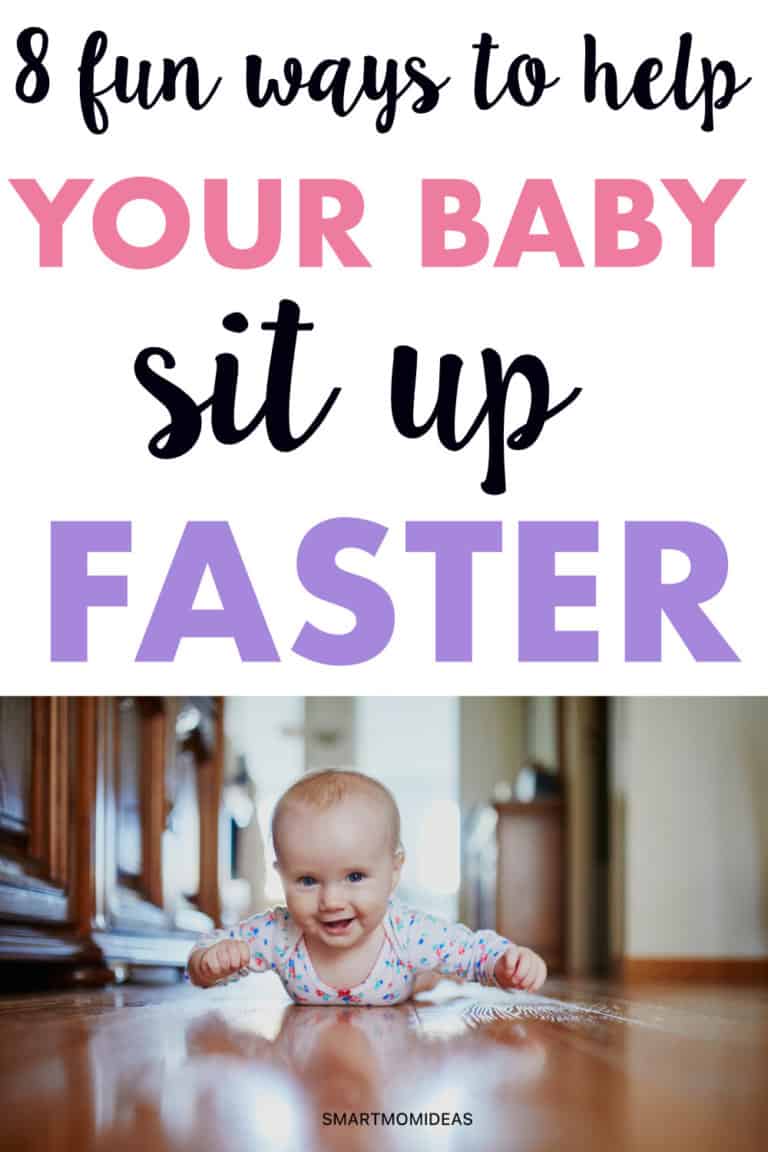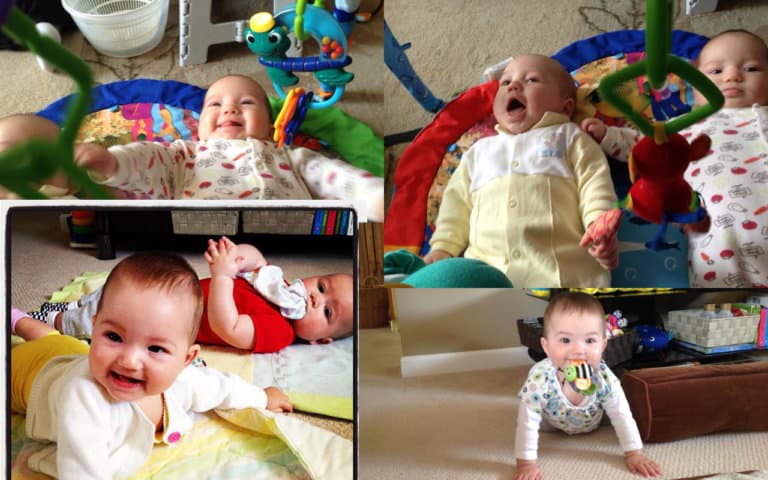Learn the fast ways to get your baby to sit up!
Your baby develops at an astonishing rate within the first 12 months of life.

It might seem like they are hitting a new milestone every day!
Laughing, clapping, rolling over, and learning to sit up on their own.
These are all gross motor skills that they need to develop first before they can start walking and running.
And believe me, once they start moving they don’t stop!
While they are going to experience a lot of milestones throughout their first 12 months and beyond, you shouldn’t rush them and always make it a fun experience for both baby and parents.
This post specifically focuses on exercises to help baby sit up on their own.
Of course, we all know at this point that babies’ moods change with the winds, so if they aren’t seeming interested in what you are trying to do with them at that moment, you can always try again later.
You don’t need to worry about having to get fancy new toys or furniture to engage in these exercises to help baby sit up alone.
You are the most important factor in helping your baby learn how to sit up on their own.
So let’s get into it!
When Do Babies Sit Up on Their Own?
For my twins, my daughter was always the first to sit up, crawl and walk.
My son…well he enjoyed having things done to him!
He loved his bottle feedings and watching his sister doing tummy time. He was very happy and content little baby boy!

Just like with all other milestones, you might be wondering, when do babies start sitting up without assistance?
Generally between the ages of three to five months is when they are able to sit up assisted, using things like pillows or other seats.
Before they are able to sit up by themselves, you can use special seats, like the Bumbo, to help them get used to the feeling of sitting upright.
*Just make sure you never leave your baby in the Bumbo alone and don’t put it on a counter! They can tip over so be on their side for sure!
When they are learning to sit up on their own, be sure that they are always on a soft surface and can’t hit their head on anything when they fall over.
One thing you can do to help protect their little heads is to get them a cushioned backpack.

They strap onto them just like a toddler leash and provide a soft landing for when they tip over.
Most babies really get the hang of sitting up all by themselves at around 9 months.
By this time their necks and back are strong enough to hold them up.
They need to be strong enough to roll over as this is an important step in learning how to sit themselves up.
There are plenty of fun activities for infants to encourage them to sit up and start moving.
Activities and Exercises to Help Baby to Learn to Sit Up
There are plenty of movements and exercises to help baby learn to sit up. But perhaps the most simple and first step is to introduce tummy time!
1. Tummy Time
Tummy time is a great starting point for getting your baby interested in moving around.
They should be laying flat on the floor, on their stomach.
They should be able to independently hold their head up so they can breathe effectively.
You should never leave your baby unsupervised and always make sure that they are fully awake and engaged in playing with your or a toy.
Tummy time is great for promoting muscle development and to help strengthen their shoulder and neck muscles.
It only takes 20 to 30 minutes a day to start building those healthy muscles and gross motor skills (although more is better).
Tummy time can also be done with baby laying on your chest or across your lap to achieve the same types of movements and benefits. Just be sure that they have something to look at and touch, such as a brightly colored toy.
2. Boppy Pillow
You might already have one of these if you are breastfeeding.
They also work great to help prop baby up to help them learn how to sit.
This is a great tool or exercise to help them build their stomach muscles as they have a little more room to freely move around, whereas a Bumbo seat can be a little more restrictive for movement. A Boppy pillow gives support around their bottom and sides and also gives them a soft landing for when they tip over.
3. Pull Ups
While baby won’t be using the pull up bar any time soon, this is one of the great physical therapy exercises to help baby sit up.
Your baby should be able to hold their head up on their own before trying this. With your baby fully awake and engaged, lay them down on the floor flat on their back.
Hold onto their hands and arms firmly and slowly pull them up to a sitting position. Do this move slowly to help engage the core muscles and get them used to the feeling of sitting upright.
Then gently and slowly lower back down to laying on their back.
Do this a few more times as long as baby is engaged.
4. Jump, Baby, Jump
If your little guy or girl is trying to get around and getting frustrated with their lack of mobility, then they are sure to love a jumperoo.
Jumperoos are filled with brightly colored and noise making toys that your baby is sure to love.
Before purchasing a jumper, be sure that your baby has strong enough neck muscles so they are safe enough to bounce around.
Jumparoos are great for building leg muscles and show your baby how fun sitting upright can be.
While jumperoos are not an essential piece of baby equipment, they sure are fun and kids tend to really enjoy them.
5. Encourage Crawling
Even if your baby is not crawling yet, there are ways that you use toys as exercises to help baby learn to sit up.
While doing tummy time, move their toys just out of reach.
Lay across from them, facing them and encourage them to move closer to the toys and to you.
Talk to them, smile, and move the toys around.
While this isn’t sitting, it will help to strengthen the muscles they need to sit up.
6. Sit and Play
Another baby exercises to help sit up uses mom or dad as the support.
Sit on the floor with your baby sitting on the floor between your legs (as shown in the image).
Not only will this help to improve your posture, it will help your baby learn to sit up also.
Grab her favorite toy and put it the level of her hands, then engage with her and move the toy up to her eye level. This helps to build neck, back, and core muscles. One of the many fun and easy exercises to do with baby to help sit up.
7. Tripod Position
Some of these exercises to help my baby sit up can be done all around the same age while others can not.
For example, they need to be able to hold up their head independently before placing them in a jumperoo.
The tripod position is similar.
Your baby needs to be able to sit up assisted with pillows or supported in some way.
The tripod position simply means that your baby can almost sit up on their own but still needs to support themselves by leaning forward and placing their hands on the floor in front of them.
After they are able to comfortably sit in the tripod position, try holding a toy around eye level so they can try and reach to get it.
Another variation of this is the ring sit.
While some babies might already do this on their own, it’s worth mentioning in our exercises to help my baby sit up.
The ring sit is simply trying to get baby to sit with their legs in a more circular position rather than straight out in front of them.
They are just another tool to help stabilize them and to get their hands off the floor.
8. Sit in a Highchair
While it’s likely that your baby is already eating some types of solid foods, you probably already have a highchair for them.
This is another great tool to use to help them sit up without assistance.
While highchairs generally have a slight decline to them, you can help baby to sit more upright and engage those core muscles by adding a blanket or towel behind their back and around their hips for extra support.
Highchairs are also great because you can put toys on the tray and they can use the tray to pull themselves forward, which is just one more way to get used to sitting and strengthen those muscles.
While babies hit milestones at different ages, don’t be discouraged if your baby is developing faster or slower than others.
They will come to reach these milestones when they are ready and with your continued help.
If you do feel that they are not reaching milestones as they should be, don’t be afraid to speak with your physician.
You know your baby best.
I hope these tips help!
Trust me, this is such a short time in your baby’s life! Before you know it, they will be sitting up, crawling and off you go!
Baby-proofing and eating grown up food!
Have fun and remember to pin me!




Leave a Reply